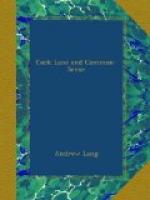Thyraeus thinks that the air is agitated when sounds are heard, but that is just the question to be solved.
As for visual phantasms, these Thyraeus regards as hallucinations produced by spirits on the human senses, not as external objective entities. He now asks why the sense of touch is affected usually as if by a cold body. Beyond assuming the influence of spirits over the air, and, apparently, their power of using dead bodies as vehicles for themselves, Thyraeus comes to no distinct conclusion. He endeavours, at great length, to distinguish between haunters who are ghosts of the dead, and haunters who are demons, or spirits unattached. The former wail and moan, the latter are facetious. He decides that to bury dead bodies below the hearth does not prevent haunting, for ‘the hearth has no such efficacy’. Such bodies are not very unfrequently found in old English houses, the reason for this strange interment is not obvious, but perhaps it is explained by the superstition which Thyraeus mentions. One might imagine that to bury people up and down a house would rather secure haunting than prevent it. And, indeed, at Passenham Rectory, where the Rev. G. M. Capell found seven skeletons in his dining-room, in 1874, Mrs. Montague Crackanthrope and her nurse were ‘obsessed’ by ’a feeling that some one was in the room,’ when some one was not. {135} Perhaps seven burials were not sufficient to prevent haunting. The conclusion of the work of Thyraeus is devoted to exorcisms, and orthodox methods of expelling spirits. The knockings which herald a death are attributed to the Lares, a kind of petty mischievous demons unattached. Such is the essence of the learned Jesuit’s work, and the strange thing is that, in an age of science, people are still discussing his problems, and, stranger still, that the reported phenomena remain the same.
That the Church in the case of Thyraeus, and many others; that medical science, in the person of Wierus (b. 1515); that law, in the book of Bouchel, should have gravely canvassed the topic of haunted houses, was, of course, very natural in the dark ages before the restoration of the Stuarts, and the founding of the Royal Society. Common-sense, and ‘drolling Sadduceeism,’ came to their own, in England, with the king, with Charles II. After May 29, 1660, Webster and Wagstaffe mocked at bogles, if Glanvill and More took them seriously.




